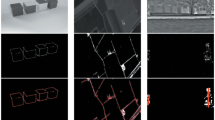Abstract
An application of line simplification considering spatial knowledge is described. A method for identifying potential conflict regions, in order to avoid the self-intersection of generalized, lines, is also discussed. Further-more, a new progressive line simplification algorithm is presented. From the view point of spatial cognition, a spatial hierarchical structure is proposed, and its application to construction of spatial knowledge related to a line is explained.
Similar content being viewed by others
References
Joao E M (1998) Causes and consequences of map generalization. London: Taylor & Francis Ltd.
Van Kreveld M, Nievergelt J, Roos T, et al. (1997) Algorithmic foundation of geographic information systems. Berlin: Springer-Verlag.
McMaster R B, Shea K S (1992) Generalization in digital cartography. Association of American Geographers.
Visvalingam M, Herbert S (1999) A computer science perspective on the bend simplification algorithm.Cartography and Geographic Information Science, 26(4): 253–270.
Dutton G H (1999(a)) A hierarchical coordinate system for geoprocessing and cartography. Berlin: Springer-Verlag
Dutton G H (1999(b)) Scale, sinuosity and point selection in digital line generalization.Cartography and Geographic Information Science, 26(1):33–53.
Kilpeläinen T (2000) Knowledge acquisition for generalization rules.Cartography and Geographic Information Science, 27(1):41–50.
Weibel R (1996) A typology of constraints to line simplification. In: Kraak M J, Molenaar M, eds. Advances in GIS Research II (Proceedings of the 7th International Symposium on Spatial Data Handling). London: Taylor & Francis. 9A. 1–9A. 14
Lechthaler M, Kasyk S (1999) Theoretical and practical deliberations with regard to semi-automated cartographic generalization.The Cartographic Journal, 36(1):59–65
Li Z, Sui H (2000) An integrated technique for automated generalization of contours maps.The Cartographic Journal, 37(1):29–37
Christensen A H J (1999) Cartographic line generalization with waterlines and medial-axes.Cartography and Geographic Information Science, 26(1):18–32
Christensen A H J (2000) Line generalization by waterlining and medial axis transformation: successes and issues in an implementation of Perkal's proposal.The Cartographic Journal, 37(1):19–28.
Saalfeld A (1999) Topologically consistent line simplification with the douglas-peuker algorithm.Cartography and Geographic Information Science, 26(1):7–18
Author information
Authors and Affiliations
Corresponding author
Additional information
Project supported by NSF (No. 49971068), National Excellent Young Teacher Fund and HUO Yingdong Fund for Young Teachers in University.
About this article
Cite this article
Qingsheng, G., Brandenberger, C. & Hurni, L. A progressive line simplification algorithm. Geo-spat. Inf. Sci. 5, 41–45 (2002). https://doi.org/10.1007/BF02826387
Issue Date:
DOI: https://doi.org/10.1007/BF02826387




